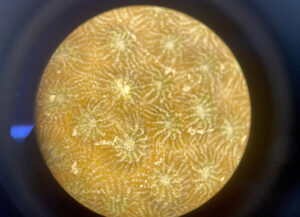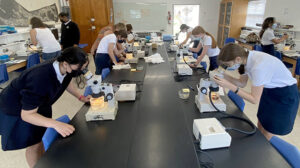Student Field Trips Resume at BIOS

During a visit to BIOS by students from the Bermuda High School for Girls, summer intern Roderick Bakker (in hat), a student from the University of Applied Sciences Leiden in the Netherlands, explained his coral research project in collaboration with BIOS marine ecologist Yvonne Sawall. The research, on coral energy production and growth rates, focuses on the long-term monitoring of the corals’ stress responses to a changing climate. “Although the research is still in its early stages, in the future we hope our research can serve as an early warning system for corals at risk of bleaching,” Bakker said.
After months of precautionary cancellations due to the pandemic, BIOS staff hosted several school groups on campus this June for marine science studies that complement public and private school curriculums.
The Bermuda High School for Girls (BHS) was the first of four local schools to arrive this month for lessons since pandemic restrictions ended on island, followed by Warwick Academy, Somersfield Academy, and Clearwater Middle School, said Kaitlin Noyes, BIOS director of education and community engagement.

Students examined boulder star coral, a species prevalent in Bermuda and throughout the Caribbean. They learned how these colonial organisms are composed of hundreds of thousands of individual animals, called polyps. Each polyp has a stomach that opens at only one end. This opening, called the mouth, is surrounded by a circle of tentacles. The polyp uses these tentacles for defense, to capture small animals for food, and to clear debris.
The BHS visit to BIOS, focused specifically on the island’s coral reefs, was a first for the school’s students, said science teacher Amanda Darrell. “It won’t be the last,” she said, describing the 55 participating students as “excited and amazed.”
The experience was part of the Year 9 marine biology curriculum for 13- and 14-year-old students attending BHS. During their 90-minute visit to BIOS, the students rotated among three indoor and outdoor lab stations to learn about coral and ongoing coral reef research. They discussed Bermuda’s unique reefs system, one of the highest-latitude reefs in the Atlantic supported by warm currents carried in by the Gulf Stream.
The students examined 15 different coral species and their basic parts, including polyps, the individual, genetically-identical organisms that make up a coral colony. They went on to learn about the relationship between coral and zooxanthellae, tiny plant cells that live within most types of coral polyps. Zooxanthellae photosynthesize, enabling the corals to share in energy captured directly from the sun.

In a BIOS lab, students visiting from the Bermuda High School for Girls examined coral under microscopes to learn about corals’ basic structure and how they grow and reproduce.
Students also learned how Bermuda’s reefs and marine environments are imperiled by a range of threats, from warming waters and acidifying seas to pollution and the invasion of non-native species, including lionfish. After, they listened to stories about ongoing research at BIOS that may serve to increase understanding of reef systems and how to protect and conserve them.
“The students were engaged, they asked important questions, and they were keen to learn about corals and the methods used to study them,” said BIOS science education officer Claire Fox. The end of the academic year this month meant that hosting additional school classes on campus will need to wait for the fall, Fox said.
Still, having dozens of local students again partaking in BIOS educational offerings in person was a reason to celebrate. “It’s wonderful to have them back on campus,” Fox said.
